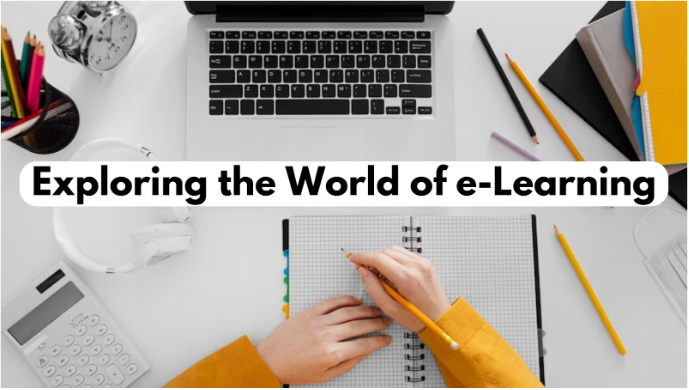What is E-Learning?
E-learning, also referred to as electronic learning, is the process of delivering education and training through digital resources. E-learning is given through online-connected technical devices such as computers, tablets, and even mobile phones, despite having a traditional education as its core. Users can easily and without many restrictions learn whenever and wherever they choose thanks to this. Online training, education, or instruction delivered through a computer or other digital device is known as eLearning
Advantages of e-learning over traditional classroom learning
E-learning has become an increasingly popular way of learning due to its convenience and cost savings. With e-learning, students can access course material anytime and anywhere, allowing them to learn at their own pace. Traditional classroom learning is often limited by space and time constraints, making it difficult for students to get the most out of their education.
E-learning also offers a wide range of advantages over traditional classroom learning. It is more cost-effective as it eliminates the need for physical infrastructure such as classrooms and textbooks. It also allows for more personalized learning experiences as learners can customize their courses according to their interests or needs. Additionally, e-learning enables learners to access a much larger range of resources than they would have access to in a traditional classroom setting. The disadvantages of e-learning include the need for greater Internet speed, which can be difficult in some countries. Additionally, e-learning is not as effective for learners who may have an attention deficit or a learning disability. Finally, e-learning requires more cognitive effort on the part of the learner, which may lead to frustration if they are not able to achieve their desired level of mastery.
Impact of e-learning on student engagement and Motivation
E-learning has revolutionized the way students learn and interact with their teachers. It has made learning more interactive and engaging, allowing students to stay motivated and engaged in the learning process. With e-learning, students can access information from anywhere at any time, making it easier for them to stay up-to-date with course material. Furthermore, e-learning allows teachers to track student progress and provide personalized feedback which encourages students to stay motivated and engaged in their studies.
By taking advantage of technology, e-learning can help create a more stimulating learning environment that encourages student engagement and motivation. Some of the benefits of e-learning are increasing student engagement; providing opportunities for personalized feedback to students; and decreasing costs in education. One challenge with e-learning is that teachers may not always be available for interaction or feedback with students and thus can\’t offer much meaningful interaction. Another challenge is that technology can cause disruptions, including decreased attention span and increased distractions; this can lead to lower levels of motivation in the classroom.
How e-learning can enhance the learning experience for students with disabilities
E-learning has become an invaluable tool for students with disabilities. It has the potential to provide a more accessible and inclusive learning experience for students who may be unable to attend traditional classrooms due to physical or mental disabilities. With e-learning, students can access educational material from anywhere in the world, at any time of day, and have the opportunity to learn at their own pace.
E-learning can also reduce barriers caused by physical disabilities. For example, it can provide tools such as text-to-speech and speech recognition software that allow students with visual impairments to read text aloud or use voice commands to navigate through digital content. Additionally, e-learning platforms often include features such as adjustable font sizes, color contrast settings, and other accessibility options that make it easier for students with different types of disabilities to access digital content. By leveraging the power of e-learning technologies, educators can create an inclusive learning environment that allows all students – regardless of their abilities – to reach their highest potential.
E-Learning localization
E-learning localization is the process of modifying online courses, videos, and interactive modules to fit the linguistic, cultural, and regional requirements of students in certain geographic locations. More than simply text translation is required for localization; the target audience\’s cultural norms and preferences must also be reflected in the visuals, audio, and video material. The language, visuals, symbols, color schemes, and even the content itself may need to be altered as part of this process to make it more understandable and successful for students in the target location. E-learning localization aims to maximize learning accessibility and engagement for students in various geographic locations, which can enhance learning outcomes and boost the use of digital learning technologies.
It is essential to realize that e-learning localization services can assist you in making sure that the course material will function properly for a user base in a different setting and culture – it goes beyond a simple translation. It makes sure that the messages are understood while maintaining their original attractiveness and efficacy. For instance, we localize not just the vocal content but also graphics, subtitles, and much more, in contrast to e-Learning translation services. Instead, of emphasizing words, localization seeks to dynamically alter the design and multimedia elements.
At DTP Labs, we are the leading and one of the most experienced eLearning translation and localization services providers across the globe. We can help you take your content truly global through our eLearning localization services. To avail of our services, check out our website www.dtplabs.com, or contact us at info@dtplabs.com.
Conclusion
E-learning is becoming increasingly popular due to its convenience and cost savings but is not as effective for learners with attention deficits or learning disabilities. It has many benefits, such as increasing student engagement and providing personalized feedback, but can also cause disruptions. To address this, e-learning technologies can be used to create an inclusive learning environment that allows all students to reach their highest potential. DTP Labs is the leading E-learning translation and localization services provider.

